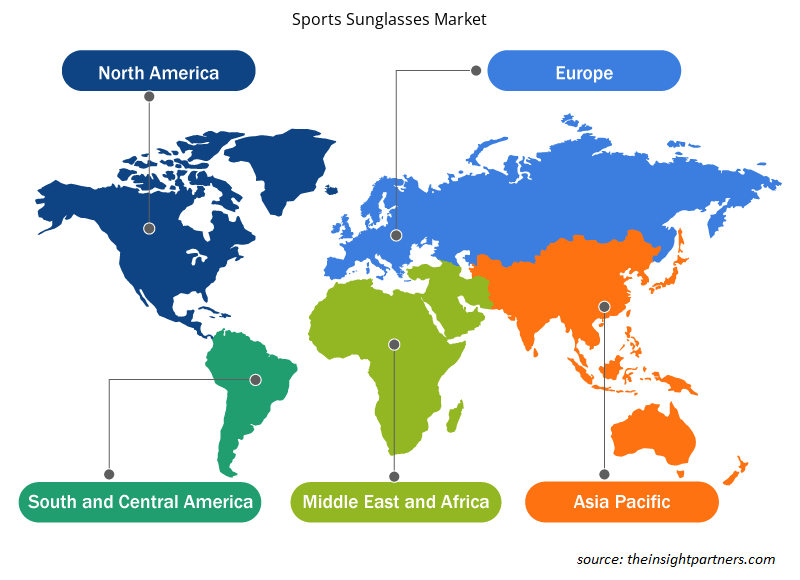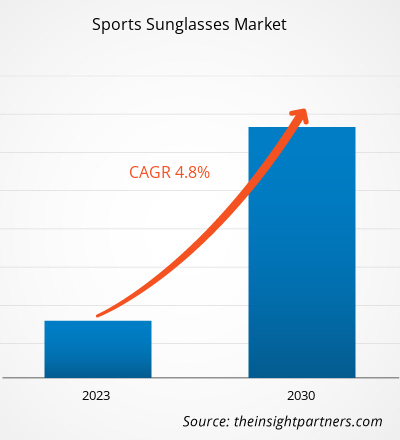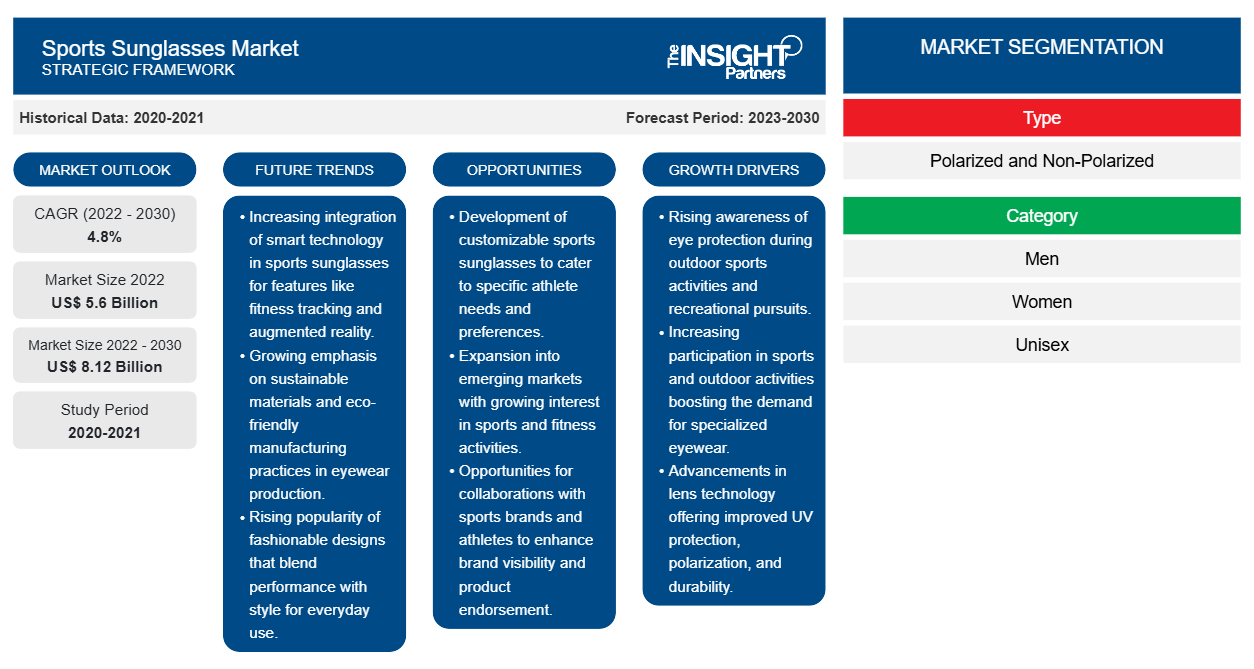[Rapporto di ricerca] Si prevede che il mercato degli occhiali da sole sportivi crescerà da 5.597,08 milioni di dollari nel 2022 a 8.115,06 milioni di dollari entro il 2030; si prevede che il mercato registrerà un CAGR del 4,8% dal 2022 al 2030.
Approfondimenti di mercato e opinioni degli analisti:
Gli occhiali da sole sportivi sono occhiali protettivi utilizzati per migliorare la visibilità e il comfort durante gli sport all'aria aperta. Riducono al minimo l'esposizione alla luce solare intensa per prevenire danni agli occhi. Le lenti sono realizzate con materiali in plastica o vetro. Sono rivestite con filtri anti-raggi ultravioletti (UV) e pellicole antiurto che riducono l'abbagliamento e migliorano il contrasto per offrire una migliore visibilità sul campo. Gli occhiali da sole sono disponibili anche in tipi polarizzati o non polarizzati con lenti colorate e non colorate, che li rendono adatti all'uso quotidiano. Gli occhiali da sole sportivi sono generalmente utilizzati durante l'esecuzione di attività sportive come ciclismo, nuoto, mountain bike, ciclismo, baseball, cricket e altre attività all'aperto. Questi fattori guidano il mercato degli occhiali da sole sportivi
Fattori di crescita e sfide:
Molte persone praticano vari sport e attività all'aperto. Gli appassionati di sport comprendono l'importanza di proteggere i propri occhi da potenziali rischi come polvere, vento e detriti. Pertanto, utilizzano occhiali da sole sportivi progettati per fornire una protezione ottimale e migliorare le prestazioni durante le attività sportive. Secondo la Sports & Fitness Industry Association (SFIA), oltre il 76% della popolazione (ovvero 236,9 milioni di persone) negli Stati Uniti ha partecipato ad almeno un'attività nel 2022, con un aumento del 9,2% nei tassi di partecipazione totale rispetto al 2017 e un aumento dell'1,9% rispetto al 2021. Inoltre, secondo Eurostat, nel 2019, circa il 44% della popolazione europea ha praticato alcune attività fisiche almeno una volta alla settimana. Inoltre, una vasta gamma di sport e attività all'aperto ha creato una domanda di occhiali da sole sportivi su misura per soddisfare esigenze specifiche.
Inoltre, il cambiamento culturale verso uno stile di vita più sano e attivo ha aumentato il numero di persone che praticano sport e attività all'aperto. Questo cambiamento non è limitato agli atleti agonisti, ma include individui che praticano sport ricreativi, corsa, escursionismo e altre attività ricreative. Gli occhiali da sole sportivi sono diventati una dichiarazione di moda e un simbolo di questo stile di vita attivo.
L'esposizione prolungata ai raggi ultravioletti (UV), specialmente in ambienti esterni, può portare a varie patologie e patologie oculari come cataratta, fotocheratite e pterigio. Queste patologie possono causare disagio, problemi alla vista e, in alcuni casi, danni permanenti agli occhi. Quando si praticano sport o altre attività all'aperto, gli individui hanno bisogno di una vista chiara e senza problemi per dare il massimo. Un'esposizione eccessiva ai raggi UV può portare a strizzare gli occhi, disagio e riduzione della chiarezza visiva. Gli occhiali da sole sportivi con protezione UV assicurano che gli atleti possano mantenere una vista e una concentrazione ottimali durante le loro attività, migliorando le loro prestazioni complessive.
Personalizza questo report in base alle tue esigenze
Riceverai la personalizzazione gratuita di qualsiasi report, comprese parti di questo report, o analisi a livello nazionale, pacchetto dati Excel, oltre a usufruire di grandi offerte e sconti per start-up e università
-
Scopri le principali tendenze di mercato in questo rapporto.Questo campione GRATUITO includerà analisi di dati che spaziano dalle tendenze di mercato alle stime e alle previsioni.
Segmentazione e ambito del report:
Il "mercato globale degli occhiali da sole sportivi" è segmentato in base a tipo, categoria, canale di distribuzione e area geografica. In base al tipo, il mercato degli occhiali da sole sportivi è diviso in polarizzati e non polarizzati. In termini di categoria, il mercato è segmentato in uomo, donna, unisex e bambino. In base al canale di distribuzione, il mercato degli occhiali da sole sportivi è segmentato in supermercati e ipermercati, negozi specializzati, vendita al dettaglio online e altri. In base all'area geografica, il mercato è segmentato in Nord America (Stati Uniti, Canada e Messico), Europa (Germania, Francia, Italia, Regno Unito, Russia e resto d'Europa), Asia Pacifico (Australia, Cina, Giappone, India, Corea del Sud e resto dell'Asia Pacifico), Medio Oriente e Africa (Sudafrica, Arabia Saudita, Emirati Arabi Uniti e resto di Medio Oriente e Africa) e Sud e Centro America (Brasile, Argentina e resto del Sud e Centro America)
Analisi segmentale:
In base al tipo, il mercato degli occhiali da sole sportivi è suddiviso in polarizzati e non polarizzati. Il segmento non polarizzato ha detenuto una quota significativa del mercato nel 2022. La domanda di occhiali da sole sportivi non polarizzati è in forte crescita tra gli atleti e gli appassionati di fitness che hanno bisogno di proteggere i propri occhi durante le prestazioni, oltre a garantire il benessere generale. I progressi nella tecnologia delle lenti hanno portato all'introduzione di occhiali da sole sportivi non polarizzati più leggeri, comodi e durevoli, che attraggono un pubblico più ampio. Inoltre, l'influenza dell'industria della moda sugli accessori sportivi ha contribuito alla popolarità degli occhiali da sole sportivi non polarizzati eleganti e funzionali tra le persone che cercano prestazioni ed estetica nelle loro scelte di occhiali.
Analisi regionale:
In base alla geografia, il mercato degli occhiali da sole sportivi è segmentato in cinque regioni chiave: Nord America, Europa, Asia Pacifico, Sud e Centro America e Medio Oriente e Africa. Il Nord America ha dominato il mercato globale degli occhiali da sole sportivi. Il mercato regionale è stato valutato a 1.791 milioni di dollari nel 2022. L'Europa è il secondo maggiore contributore al mercato, che detiene quasi il 25% del mercato globale. Si prevede che il Medio Oriente e l'Africa registreranno un CAGR del 6,5% nel mercato degli occhiali da sole sportivi durante il periodo di previsione. In Nord America, si prevede che il mercato crescerà in modo significativo a causa della crescente partecipazione agli sport e della crescente consapevolezza relativa alla protezione degli occhi. Secondo la Sports & Fitness Industry Association (SFIA), oltre il 76% di tutti gli americani, ovvero 236,9 milioni di persone, ha partecipato ad almeno un'attività sportiva nel 2022. Quindi, la crescente partecipazione dei nordamericani a diverse categorie sportive alimenta ulteriormente la domanda di occhiali da sole sportivi in tutta la regione. Inoltre, il mercato in Medio Oriente e Africa ha registrato una crescita notevole grazie agli ingenti investimenti governativi nel settore sportivo. Ad esempio, gli stati membri del Consiglio di cooperazione del Golfo (GCC), tra cui Arabia Saudita ed Emirati Arabi Uniti, hanno speso oltre 65 miliardi di dollari USA per lo sviluppo sportivo nel 2022, con un'attenzione primaria al calcio e agli e-sport, che sono considerati quelli con il potenziale di crescita dei ricavi più significativo. La crescente consapevolezza dell'importanza dello sport e della forma fisica tra individui e appassionati di fitness spinge la domanda di occhiali da sole sportivi in Medio Oriente e Africa.
Sviluppi del settore e opportunità future:
Di seguito sono elencate le varie iniziative intraprese dai principali attori del mercato degli occhiali da sole sportivi:
- Nel dicembre 2022, SunGod, un marchio di occhiali britannico, ha collaborato con un team di ciclismo critico con sede a Londra per lanciare Tekkerz Vulcanz, gli occhiali da sole Vulcanz. Il modello include una lente fotocromatica, una montatura in polimero con memoria di luce ultravioletta e cuscinetti auricolari e naselli idrofili.
Approfondimenti regionali sul mercato degli occhiali da sole sportivi
Le tendenze regionali e i fattori che influenzano il mercato degli occhiali da sole sportivi durante il periodo di previsione sono stati ampiamente spiegati dagli analisti di Insight Partners. Questa sezione discute anche i segmenti e la geografia del mercato degli occhiali da sole sportivi in Nord America, Europa, Asia Pacifico, Medio Oriente e Africa e America meridionale e centrale.

- Ottieni i dati specifici regionali per il mercato degli occhiali da sole sportivi
Ambito del rapporto di mercato sugli occhiali da sole sportivi
| Attributo del report | Dettagli |
|---|---|
| Dimensioni del mercato nel 2022 | 5,6 miliardi di dollari USA |
| Dimensioni del mercato entro il 2030 | 8,12 miliardi di dollari USA |
| CAGR globale (2022-2030) | 4,8% |
| Dati storici | 2020-2021 |
| Periodo di previsione | 2023-2030 |
| Segmenti coperti |
Per tipo
|
| Regioni e Paesi coperti |
America del Nord
|
| Leader di mercato e profili aziendali chiave |
|
Densità degli operatori del mercato degli occhiali da sole sportivi: comprendere il suo impatto sulle dinamiche aziendali
Il mercato degli occhiali da sole sportivi sta crescendo rapidamente, spinto dalla crescente domanda degli utenti finali dovuta a fattori quali l'evoluzione delle preferenze dei consumatori, i progressi tecnologici e una maggiore consapevolezza dei vantaggi del prodotto. Con l'aumento della domanda, le aziende stanno ampliando la propria offerta, innovando per soddisfare le esigenze dei consumatori e capitalizzando sulle tendenze emergenti, il che alimenta ulteriormente la crescita del mercato.
La densità degli operatori di mercato si riferisce alla distribuzione di aziende o società che operano in un particolare mercato o settore. Indica quanti concorrenti (operatori di mercato) sono presenti in un dato spazio di mercato in relazione alle sue dimensioni o al valore di mercato totale.
Le principali aziende che operano nel mercato degli occhiali da sole sportivi sono:
- Decathlon
- Adidas AG
- Gruppo Luxottica
- Sport della libertà
- Nike Inc
Disclaimer : le aziende elencate sopra non sono classificate secondo un ordine particolare.

- Ottieni una panoramica dei principali attori del mercato degli occhiali da sole sportivi
Impatto della pandemia di COVID-19:
La pandemia di COVID-19 ha avuto effetti negativi su quasi tutti i settori in vari paesi. I lockdown, le restrizioni di viaggio e le chiusure delle attività in Nord America, Europa, Asia Pacifico (APAC), Sud e Centro America e Medio Oriente e Africa (MEA) hanno ostacolato la crescita di diversi settori, tra cui il settore dei beni di consumo. La chiusura delle unità produttive ha disturbato le catene di fornitura globali, le attività di produzione, i programmi di consegna e le vendite di prodotti essenziali e non essenziali. Diverse aziende hanno segnalato ritardi nelle consegne dei prodotti e un crollo delle vendite dei loro prodotti nel 2020. Inoltre, nel primo periodo della crisi, i produttori dipendevano in modo significativo dall'inventario esistente. A causa della recessione economica indotta dalla pandemia, i consumatori sono diventati più cauti e selettivi nelle decisioni di acquisto. Hanno limitato significativamente gli acquisti non essenziali a causa di redditi più bassi e prospettive di guadagno incerte, soprattutto nelle regioni in via di sviluppo.
Entro la fine del 2021, molti paesi erano completamente vaccinati e i governi hanno annunciato allentamenti in alcune normative, tra cui lockdown e divieti di viaggio. I cambiamenti nelle tendenze dello stile di vita post-pandemia, come la crescente enfasi su comfort, praticità e personalizzazione, hanno influenzato la domanda di occhiali da sole sportivi. La crescita della vendita al dettaglio online durante la pandemia ha anche offerto opportunità ai produttori di occhiali da sole sportivi. Insieme a questo, l'allentamento delle restrizioni commerciali ha aiutato le operazioni di importazione ed esportazione, influenzando positivamente la crescita del mercato degli occhiali da sole sportivi.
Scenario competitivo e aziende chiave:
Columbia Sportswear Co, EssilorLuxottica SA, Liberty Sport Inc, Under Armour Inc, Nike Inc, Rapha Racing Ltd, Puma SE, Decathlon SE, Adidas AG e Safilo Group SpA sono tra i principali attori che operano nel mercato globale degli occhiali da sole sportivi. Questi attori di mercato adottano iniziative di sviluppo strategico per espandersi, guidando ulteriormente la crescita del mercato.
- Analisi storica (2 anni), anno base, previsione (7 anni) con CAGR
- Analisi PEST e SWOT
- Valore/volume delle dimensioni del mercato - Globale, Regionale, Nazionale
- Industria e panorama competitivo
- Set di dati Excel
Report recenti
Testimonianze
Motivo dell'acquisto
- Processo decisionale informato
- Comprensione delle dinamiche di mercato
- Analisi competitiva
- Analisi dei clienti
- Previsioni di mercato
- Mitigazione del rischio
- Pianificazione strategica
- Giustificazione degli investimenti
- Identificazione dei mercati emergenti
- Miglioramento delle strategie di marketing
- Aumento dell'efficienza operativa
- Allineamento alle tendenze normative























 Ottieni un campione gratuito per - Mercato degli occhiali da sole sportivi
Ottieni un campione gratuito per - Mercato degli occhiali da sole sportivi